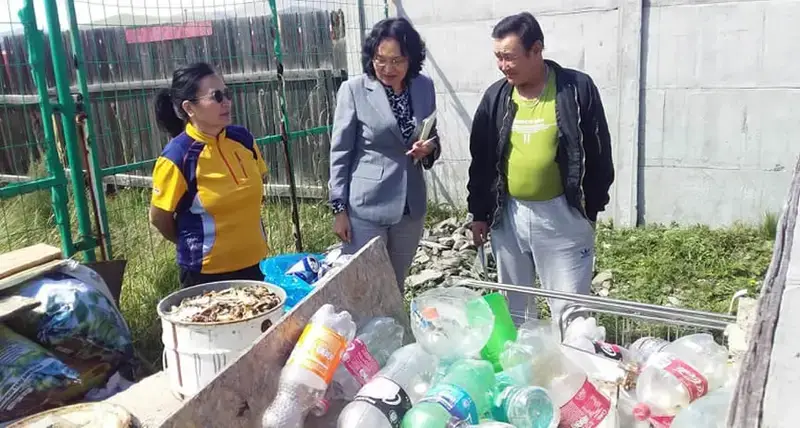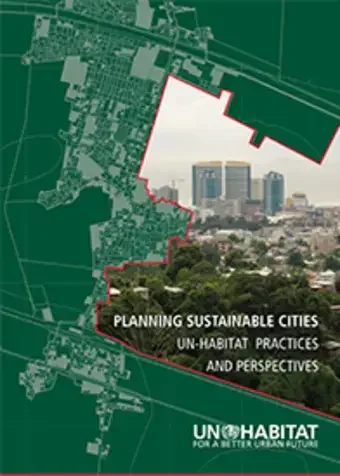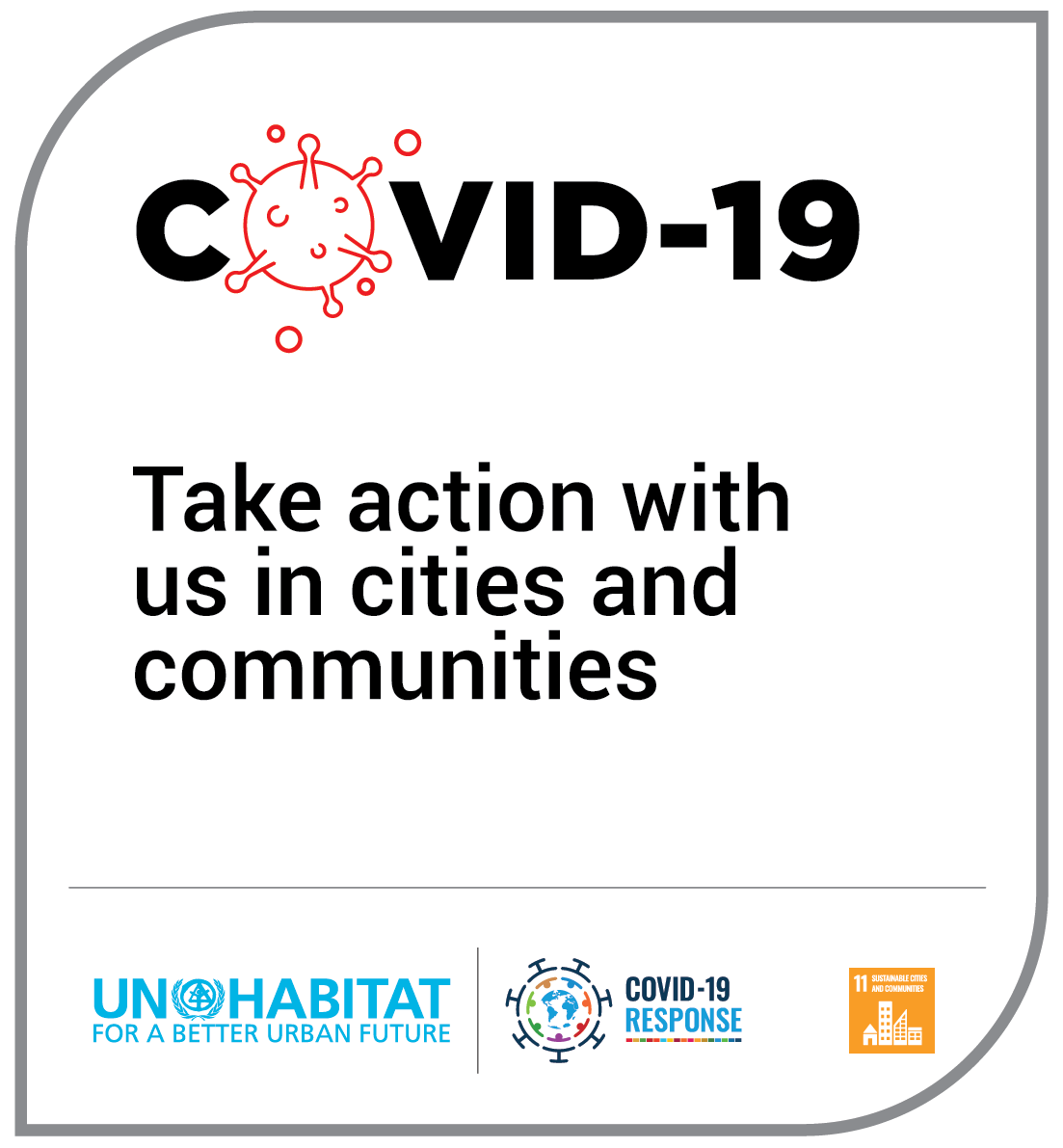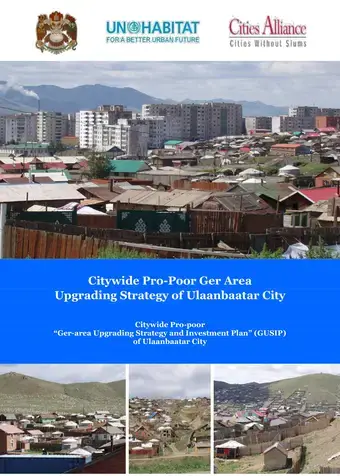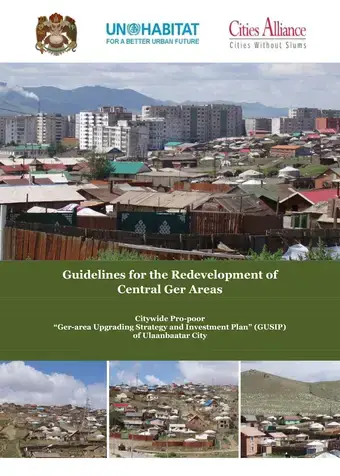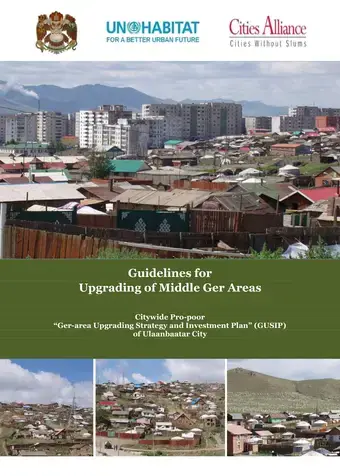Overview
Since 2006 UN-Habitat has supported the Government of Mongolia and Municipality of Ulaanbaatar City in ger area (informal settlement) upgrading policy formulation and its implementation and National Urban Policy development. Through its technical assistances, UN-Habitat aimed to introduce the participatory planning and development approaches into the conventional urban development and planning systems of the country.
Mongolia has a population of 3.03 million, growing at a rate of 1.7 percent annually. Almost half (47 percent) of the country’s population is currently living in its capital city and the share of the urban population has increased to 67 percent of the total population. Since the 1990s, Ulaanbaatar-Capital city of Mongolia has had limited formal extension of its core, which largely comprises apartment blocks with comprehensive utility services, including dedicated heating, water, and sanitation. However, successive waves of in-migration with Ger tents have reshaped the city’s geography, with (i) little improvement or extension of basic urban services; and (ii). A vast, low-density peri-urban area, commonly and collectively referred to as Ger areas, now extends around the city core, characterized by unplanned settlements of low- and medium-income households with land ownership, un-serviced plots, unpaved roads and poor facilities due to government policy since 2003, to grant each citizen about 700 square meters of land. Settlement growth here is much faster than urban development and is projected to increase by another 40 percent by 2020.
Lack of long-term planning, infrastructure investment, and land use regulation in Ger areas have resulted in haphazard development, limited availability of space for public facilities, poor access to socioeconomic services and insufficient livelihood opportunities. The lack of basic urban infrastructure is preventing people to move out of poverty. The service gap between the city core and Ger areas means Ger residents are poorly connected to the city core and poorly integrated in the urban economy, and this is one of the most urgent and difficult development challenges. While various government and development partner initiatives have significantly improved living conditions in Ger areas, approaches have generally focused on specific sectors, failing to design a sustainable vision and provide integrated solutions for the problems.
Urban population (% of total) in Mongolia was reported at 72.82 % in 2016.
47 percent of the Mongolia population is currently living in Ulaanbaatar- the capital city.
54.4 % of Ulaanbaatar city’s population live in Ger areas with inadequate basic services
Country Beneficiaries
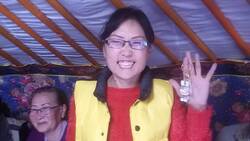
Under the UN-Habitat project for Community Engagement and SME Development, I got the training on household’s finance management and a business proposal development. I found these very helpful to improve my livelihood. I’m already applying the knowledge I gained from the training to my life. Members of my family started collecting money for personal savings. Even my son is trying to manage his financial needs now. Once he found and read my training notes, which was left at the desk and asked me what the savings are. I explained to him and the next day he requested me to go shopping for a piggy bank to collect his money. He has set a goal to collect 100 MNT every day so he would be able to pay for his student tuition for university after graduating from secondary school. The training has made many changes in my family, now it is my goal to learn from my son and do some savings every day.
Ms.Tungalag, CDC Member, Khoroo No 7 Songinokhairkhan District, Ulaanbaatar city
Donors and partners
UN-Habitat works in close collaboration with national and local governments, international and national non-government organizations, academia, community organizations and communities.
Donors
Highlighted Publications
Legacy content
- Total value of UN-Habitat investments (2008-2013): US$ 69,265
- Total number of UN-Habitat projects (2008-2013): 1 project
- Main donors: Asian Development Bank (ADB)
Mongolia is located in the heart of Central Asia, between Peoples’ Republic of China and the Russian Federation. Total population is about 2.7 million living over the territory of density 1,566,500 km2. Since early 1990s the country made steady progress from planned to a market-let economy which is migrated sparely settled nomadic population to capital city, Ulaanbaatar. As a result, over 60 percent of the nation’s population is now urban.
General information
2010 2011 2012 Urban Population 1,910,745 1,896,293 1,926,625 Level of Urbanization (%) 69.02 67.44 67.18 Poverty level (%) 38.7 33.7 27.4 Poverty level of Urban (%) 33.1 28.6 23.2 Improved Drinking water Coverage (%) over 50 82 n/a Improved sanitation coverage (%) over 30 51 n/a
UN-Habitat projects in Mongolia
The UN-Habitat has been working in Mongolia since 2006 with focus on the city of Ulaanbaatar city’s with the key activities on development areas highlighted below:
1) The Citywide Ger Area Upgrading Strategy and Investment Plan Project (GUSIP, 2006-2010) funded by the Cities Alliance has assisted the Municipality of Ulaanbaatar (MUB) in the preparation of the first Citywide Pro-poor Ger-area Upgrading Strategy of Ulaanbaatar City in 2006-2007, which was approved by the Ulaanbaatar City Citizens’ Representative Council in July 2007 for its implementation. The Strategy classified the ger areas into three zones: central, middle, and peri-urban, which enabled the government and its development partners to properly nuance the interventions based on the characteristics of each zone.
2) The Community-Led Ger Area Upgrading Project in Ulaanbaatar City in Mongolia (2009-2013) was launched to support the implementation of the above Ger area Upgrading Strategy in the middle ger areas of Ulaanbaatar City. The project’s goal was to improve the quality of life of approximately 50,000 ger area residents in Ulaanbaatar City through a community-led ger area upgrading approach in the five selected project areas. Under the community mobilization component of the project 5 khoroo CDCs and 47 kheseg CDCs, 191 primary groups have been organized and remained active. The CAPs were reviewed and updated annually to reflect the change in priority needs of the communities. 15 community facilities and 135 small access infrastructures identified based on the CAPs have been constructed and are being used by the area residents. 792 CDC members and other residents got temporary employment while building the sub- and micro-projects. 81 community members got permanent employment after community facilities started their operation. 17 Community members got temporary employment as construction workers implementing sub-project.
Contacts
UN-Habitat Mongolia Room #609, UN-HouseUnited Nations Street-12Sukhbaatar DistrictUlaanbaatar -14201, Mongolia Telephone: +976-11-322711 Fax: + 976-11-322711 Email: mail@unhabitat-mongolia.org
Images

